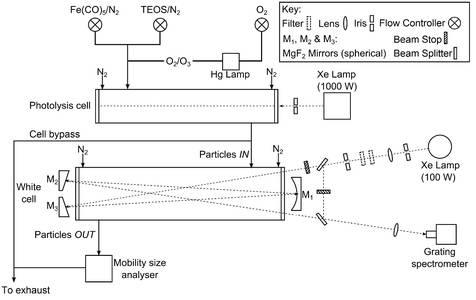Photochemistry of Meteoric smoke particle analogues
Middle/Upper Atmosphere Laboratory, Current Research.
A number of MSP analogues with possible smoke compositions have been generated in the laboratory using a photochemical aerosol flow reactor [Saunders and Plane, 2006; 2010; 2011]. Particles with compositions akin to the minerals hematite (Fe2O3) and fayalite (Fe2SiO4) have been produced. Particle size distributions were measured using a Scanning Mobility Particle Sizer (SMPS) and optical extinction measurements were obtained, for comparison with values calculated from Mie theory using literature refractive index data of the unidentified particles. Particles were captured for morphological and compositional analysis using Scanning Electron Microscopy (SEM).
The experimental size distributions of the MSP analogues produced can be replicated using an agglomeration model which includes both Brownian and magnetic collision kernels [Jacobson, 2005]. Mie theory is able to replicate the measured extinction of Fe2O3 and Fe2SiO4 particles, although not when using the experimental size distribution. Current work aims to generate fits to both the measured size distributions and extinction profiles with appropriate parameters, and to establish whether the refractive indices for the fractal agglomerates generated are close enough to those for the bulk crystalline material (available in the literature) that they can be reliably used for the estimation of smoke composition from optical measurements in the upper atmosphere.

References
[1] Saunders, R. W., and J. M. C. Plane (2006), A laboratory study of meteor smoke analogues: Composition, optical properties and growth kinetics, J Atmos Sol-Terr Phy, 68(18), 2182-2202
[2] Saunders, R. W., and J. M. C. Plane (2010), The formation and growth of Fe2O3 nanoparticles from the photo-oxidation of iron pentacarbohyl, J Aerosol Sci, 41(5), 475-489
[3] Saunders, R. W., and J. M. C. Plane (2011), A photo-chemical method for the production of olivine nanoparticles as cosmic dust analogues, Icarus, 212(1), 373-382
